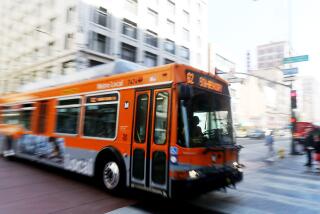Less invasive body scanner software tested at airports
- Share via
Reporting from Washington — As the uproar over the government’s use of pat-downs and full-body scanners at airports ebbs, new technology is being tested that is designed to allay privacy concerns over the grainy nude images produced by the machines.
Scanners being tested in three U.S. airports starting this week will display for screeners a generic stick figure, and any suspicious object on a passenger’s body will be flagged for inspection by a pale red box on the drawing. A passenger cleared to go will see the screen flash green and read “OK.”
The software debuts as complaints by air travelers over the new security measures have remained relatively low. Of the 100 million fliers that have passed through airport checkpoints since Nov. 1, the Transportation Security Administration has received fewer than 5,500 complaints about the procedures.
And most of those complaints, TSA officials said, were not from individuals who were flying. Fewer than 800 complaints about the pat-downs and 300 complaints about the full-body scans were lodged by actual travelers. The rest came from individuals who had not gone through the procedures but nonetheless complained about them, TSA officials said.
The software being tested would be used to replace the revealing images generated by millimeter wave scanners and currently viewed by a TSA agent in a separate room. The new computer program identifies hidden foreign objects and indicates to TSA searchers where to look during a pat-down.
Full-body scanners are able to detect non-metallic items, such as the explosives used in the attempted Christmas Day bombing in 2009, TSA Administrator John Pistole said at a demonstration of the new software Tuesday. The TSA instituted the new procedures in response to an elevated threat to airlines after a thwarted mail bomb plot originating in Yemen in October.
Though the new software could address privacy concerns, it does not answer complaints about the radiation from another type of scanner, called a backscatter, that works using low-dose X-rays. Studies have shown that passengers would have to pass through a backscatter machine 5,000 times before being exposed to the same amount of radiation in a single chest X-ray.
There are 486 body scanners in use in 88 airports, according to the TSA, up from 365 in 68 airports in November. TSA officials said publicly in November they hoped to have more than 1,000 body scanners in place by the end of 2011, but uncertainty over budget negotiations in Congress could hamper that goal.
Testing of the new software, which currently works only on the millimeter wave scanners, begins this week at three airports: Reagan National in Washington, D.C.; Las Vegas McCarran International; and Hartsfield-Jackson Atlanta International.
If the testing meets a “high detection standard,” Pistole said, it would be inexpensive to install the new software on the millimeter wave body scanners already in place. A similar software upgrade is being developed for the backscatter scanners.
More to Read
Inside the business of entertainment
The Wide Shot brings you news, analysis and insights on everything from streaming wars to production — and what it all means for the future.
You may occasionally receive promotional content from the Los Angeles Times.











